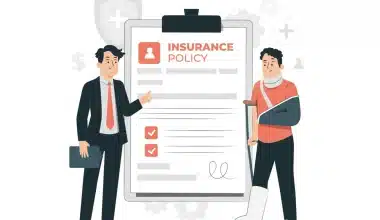Semi-insurance, also known as trucking insurance, is a type of commercial insurance that protects semi-truck owners and operators from financial losses in the event of an accident or other covered event. Semi-insurance is required by law in most states, and it can help cover the costs of repairs, medical bills, and lawsuits.
So in this article, we will cover everything you need to know about semi-insurance, including the different types of coverage available, the cost of semi-insurance, and the best options for semi-insurance.
What is Semi Truck Insurance?
Semi-insurance and commercial auto insurance protect all moving goods, trucks, and drivers. Liability coverage is frequently included in semi-insurance policies. This helps shield your firm from expensive claims if one of your truck drivers damages another person’s property or injures them while operating a company-owned semi-truck. Protecting yourself when driving is critical, whether you own a fleet with for-hire drivers, lease your semi truck to a motor carrier, or work independently.
Businesses that use trucks, independent truck drivers, and trucking companies are all protected by commercial truck insurance. This manual will cover all the details contractors and business owners need to know before purchasing commercial vehicle insurance. More specifically, this guide will cover business requirements, how to acquire a truck insurance quotation, the best insurance companies, and how commercial truck insurance operates.
How Does Semi-Insurance Work?
The broader category of business auto insurance includes commercial truck insurance. However, truck drivers and companies that use trucks are the only ones who use commercial trucking insurance.
The owner of the targeted trucks often obtains truck insurance to insure those vehicles. Only those named on the insurance policy are covered when they use the vehicle for business travel. The cost of the coverage will also depend on the people listed on it because their driving records play a significant role in establishing monthly costs.
The following categories best describe the kinds of companies and people who typically purchase:
#1. Owner Operators
These people run their own trucking company out of their homes. Individuals are the most frequent subject of this expression and most frequently own automobiles. The “owner” of the vehicle may occasionally be a motor carrier that holds it; in these circumstances, the vehicle’s owner typically insures it.
#2. Private Carriers
People transport items for their employers using their vehicles. People who frequently use their vehicles to transport items for their jobs may be asked to get insurance or may receive payment from their employer to cover the insurance cost.
These companies can all buy commercial vehicle insurance. A single box truck or a fleet of semi-insurance vehicles can be covered. The owner must define the following elements with an insurance provider before selecting a policy:
- The coverage determines which damages, occurrences, and costs are covered.
- The amount that the policyholder must pay each month to maintain the policy
- The sum an insured company must contribute to a claim before insurance coverage begins is the deductible.
#3. Policy Limit
The policyholder purchases the coverage outlined in the policy agreement through a monthly fee. According to the contract’s provisions, the insurance provider will cover any damages, repairs, medical, or other costs related to a covered incident. Typically, an incident is only covered if the driver and the vehicle are both named on the policy and occur while conducting business.
The policyholder must “file a claim” with the insurance provider after an occurrence, such as a collision, usually within a few days. The policyholder is accountable for any costs incurred up to the deductible if the insurance covers the incident. The insurer covers additional costs above the deductible and up to the policy maximum.
Semi-Insurance Coverages
Different forms of covering are needed depending on the various truck types and their applications. Because of this, policies are frequently designed using various coverage options bundled into a single policy that offers all the protection a business or individual requires. A list of the many coverage choices may be seen below.
#1. Primary Liability
Primary liability insurance is frequently offered as a combined single limit (CSL), covering property and bodily injury damages. Let’s say a driver protected by the policy causes an accident. The insurance will pay for the injured party’s medical costs and the cost of the injured party’s repairs if the driver injures or damages another person’s vehicle during the incident. However, the truck and driver who caused the collision are not covered. For this reason, motor carriers also choose to carry physical damage and medical payment coverage.
#2. Physical Damage
Physical damage coverage pays for damage to the policyholder’s vehicles involved in an accident, whereas primary liability only covers the costs of harm or damages to third parties. Also, physical damage insurance includes collision coverage (damage resulting from collisions) and comprehensive coverage (losses or damage resulting from non-collision events, such as theft or vandalism).
#3. Uninsured and underinsured drivers
The most significant cars and trucks on the road are frequently commercial trucks. The motorist at fault in an accident involving one of your vehicles won’t have enough insurance to cover your injuries and property damage. Instead, the expenses will be covered by uninsured/underinsured motorist policy.
#4. Medical Expenses
Getting medical payment coverage is helpful because private liability insurance only pays for bodily injuries to other people involved in an accident where your truck is at fault and covers your and your passengers’ potential medical expenses.
#5. Coverage for Motor Truck Cargo
In an incident like a fire or collision, motor truck cargo coverage protects the freight that a for-hire trucker transfers from one location to another. Legally speaking, truckers are obligated to insure their goods during transit and until it is signed for at the final destination.
Motor truck cargo coverage is only available to for-hire drivers of semis, dump trucks, tractors, trailers, box trucks, cement mixers, cargo vans, dually pick-ups, flatbeds, and car hauliers. Other trucking vehicles like garbage trucks, passenger trucks, and ice cream trucks are prohibited. Additionally, not every kind of goods qualifies for insurance. These include explosives, live animals, drugs, tobacco, jewellery, fine art, and jewellery, all needing separate insurance.
Different Truck Types Covered by Semi-Insurance
The following trucks and carriers may require particular types of liability protection under a semi-insurance policy:
#1. Owner Operators
Owner-operators need semi truck insurance whether they drive on their authority or a long-term lease to a motor carrier. Consider carrying additional truck insurance protections like Non-Trucking Liability Coverage and Trailer Interchange Insurance.
#2. Motor Carriers
To safeguard their fleet and business operations, motor carriers who use independent contractors on a long-term lease or for-hire truckers must carry semi-truck insurance. Even if you have Primary Liability Insurance from your motor carrier, you could still require additional protection for your vehicles, such as Physical Damage Coverage and Non-Trucking Liability Insurance.
#3. Private Carriers
Private carriers drive their truck to transport items on behalf of a business or employer. Getting semi-truck insurance is a good option to shield your truck and company from liability claims such as property damage or bodily injury if you have an accident at work.
Types of Truck Covered
Commercial truck insurance coverage can cover almost any truck. However, different insurance companies could only cover particular kinds of trucks. A typical commercial auto insurance policy may also cover some “trucks” if they aren’t utilised “as trucks” or how this kind of coverage is intended. Here is a summary of the many truck types with commercial insurance coverage.
#1. Trucks Pickup
Depending on their intended purpose, pickup trucks may be covered by a commercial or personal auto policy. Any person driving a pickup truck for work will likely require commercial truck insurance, including liability coverage, physical damage coverage, and uninsured or underinsured motorist coverage. This includes landscapers, construction workers, and other professionals. A personal car policy is adequate for people who utilise a pickup truck as their primary vehicle for non-commercial use.
#2. Truck Boxes
Large objects like furniture are transported using straight or box trucks. These vehicles’ rectangular (“boxlike”) cargo hold makes them simple to recognise. These automobiles weigh between 12,500 and 33,000 pounds and range from 10 to 26 feet. Cargo cutaways, ice box trucks, moving trucks, reefer/refrigerator trucks, and sleeper box trucks are a few examples of several kinds of box trucks.
Box trucks should also have motor truck cargo coverage to safeguard the items themselves, along with main liability and physical damage coverage and non-trucking liability coverage to protect the truck when it is not in use.
#3. Concrete Mixers
Concrete is transported to and from building sites using cement mixers. The drum that contains the concrete and retains it in liquid form on these trucks is what makes them famous. Since cement mixers have a high centre of gravity and a propensity to topple over, they are frequently involved in accidents. Higher insurance prices reflect the elevated risk. Liability, property damage, medical costs, and uninsured or underinsured motorists coverage should all be included for cement mixers.
#4. A Tow Truck
Transporting other vehicles or watercraft from one location to another is what tow trucks do. Physical damage and liability insurance coverage are required for tow trucks. On-hook towing insurance, which pays for repairs to the automobiles being towed, is also advantageous to tow trucks. Some insurance firms provide towing company-specific policies. For more details, go to this comprehensive tow truck insurance guide.
#5. Trucks and Tractors
Tractors are typically employed in agriculture for duties like planting and ploughing, while most of the other truck types on this list are used for moving things between locations. Rather than travelling on a road, tractors typically stay on a farm. Tractors are among a farmer’s most significant equipment, so it’s crucial to insure them. Occasionally, insurance companies offer coverage designed expressly for farming, which might include tractors. It is preferable to consult with an agent because this depends on the insurer.
A lorry, usually called an 18-wheeler or a lorry, is another typical type of tractor. To transport freight, semis comprise a tractor unit connected to a semi-trailer. Business owners that deal with semi-trucks should consider coverage for motor truck cargo and trailer interchange in addition to primary liability and physical damage coverage.
What is Not Covered by Commercial Truck Insurance
Commercial vehicle insurance coverage will mention exclusions along with what is covered. Exclusions could apply to specific incident categories or specific cargo types. Many business truck insurance exclusions are comparable to those in commercial vehicle plans. These consist of:
#1. Intentional Injury
Insurance companies won’t pay for any losses or injuries brought on by malicious damage to someone else’s person or property. Insurance fraud is the intentional infliction of harm with the intent to deceive the insurance company into paying for damages; it is punishable by both civil and criminal laws.
#2. Others’ Property
Even if the policy covers the person taking care of the property or car, many commercial truck insurance policies do not cover damages to other people’s property, possessions, or vehicles. There are additional coverage alternatives you might look into if your business frequently moves people’s vehicles or property.
#3. Damages that Go Over Policy Limits
There is a maximum amount that each policy’s insurance provider will cover for claims. Damages above the coverage limit will not be compensated. Business owners may want to add an excess liability (or umbrella) policy to increase coverage limits.
#4. Specific Kinds of Cargo
Additionally, many cargo types are not covered by commercial truck insurance policies. These include contraband, live animals, items in the ownership of another carrier, valuables like cash and jewellery, explosive materials, and drugs, including alcohol, tobacco, and prescription medications. These kinds of cargo can occasionally be insured using additional choices for coverage, such as livestock cargo insurance and hazmat insurance.
#5. Model Policy
Request a sample policy from the insurance provider to have a clearer picture of what is covered and what isn’t under commercial truck insurance coverage. Here is a sample motor truck cargo coverage form from the National General to understand a potential policy form. To ensure your bases are covered, you should obtain numerous samples for various policy categories (such as primary liability and motor truck cargo coverage).
Costs of semi-insurance
The amount a business owner must pay in monthly premiums is often called the “cost” of an insurance policy. More expensive monthly premiums are correlated with higher policy limits. The price of commercial truck insurance varies widely based on the type of truck (such as a semi-truck, box truck, cement mixer, etc.), the truck’s size, the deductible, the type of cargo, and the location.
How much Does Insurance for commercial Trucks Run?
The typical monthly premium for a commercial truck insurance policy ranges from $703 for specialist truckers to $1,118 for transport truckers (or, on average, $8,400 to $13,500 annually). However, owner-operators who have a long-term lease with a motor carrier typically have to spend less out of pocket because the motor carrier typically pays for the primary insurance. However, owner-operators operating under their authority must pay the total cost of their truck and driver insurance, which raises costs. The range can be extensive, ranging from $2,000 to $18,000 or more, depending on how much or how little additional coverage is required.
Why is Trucking Insurance so Expensive?
Your insurance costs are significantly impacted by the highways that your trucks travel on. For instance, you must pay higher insurance premiums if most of your operations occur in urban regions with high traffic and population densities because there is a significant increase in the likelihood of an accident.
How can I Lower my Semi Truck Insurance?
- Hire seasoned drivers.
- Consider your drivers’ ages to reduce the cost of semi-truck insurance.
- Employ Safe Drivers to Meet the Requirements for Cheap Truck Insurance.
- To get the best truck insurance rates, confirm the driver’s employment history.
- Utilise newer trucks.
Which State has the Most Semi Trucks?
Nearly 166.1 million personal and business trucks were registered in the US in 2021. California and Texas had the most licenced trucks, with 15.9 and 14.6 million vehicles, respectively.
How to Save Money on Trucking Insurance?
All you need to do is put safety measures in place.
Trucking firms with a strong safety record frequently receive savings from insurance providers like CarrierHQ. Your insurance rates can be lowered by implementing safety measures like driver training programmes and regular car maintenance.
Are Trucks Higher on Insurance?
Trucks provide a significant financial risk to an insurance company because they may cause more significant damage in an accident and cost more to repair or replace. To protect itself, the insurer raises the premium for certain cars.
Conclusion
Semi-insurance aims to protect against accidents that might otherwise incur significant out-of-pocket expenses. Compared to a personal or smaller commercial vehicle, the economic harm caused by trucking accidents is more significant with more extensive and heavier vehicles. Therefore, business owners should carefully assess an insurer’s financial standing because that will decide the insurer’s capacity to pay high-cost claims. Public insurance companies are supposed to make their financial records available to the public so that you can perform your study.






